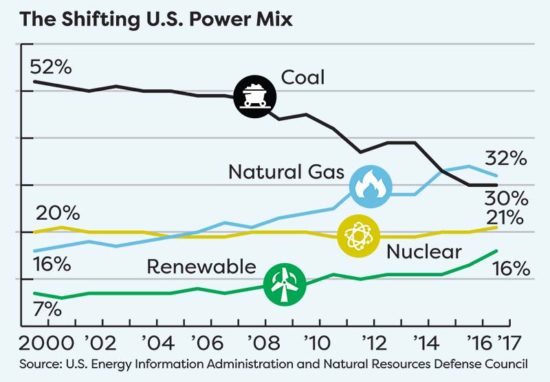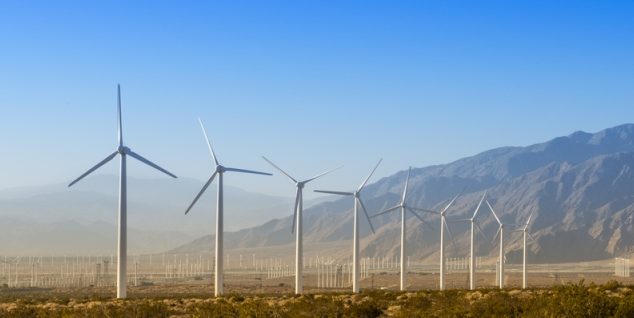California ranks first among the 50 states in its capacity of solar energy, and ties for first with Nevada in the percentage its in-state, solar power generation, while ranking fourth in wind power. Texas, meanwhile, leads the nation in wind power production.

Coal, which generated more than half of U.S. electricity in 2000, produced 30 percent last year, about the same as the year before. According to government projections, by 2035 renewable sources will outstrip coal in electric power generation.
“We’ve seen the administration take a pretty anti-clean energy approach,” said NRDC energy analyst Amanda Levin. Even so, she said, “we continue to see growth in wind and solar due to the economics of clean energy as well as state and corporate interest in investing in and promoting clean energy.”
In his election campaign and since taking office, Trump has called for a coal comeback. “We have ended the war on American energy – and we have ended the war on beautiful, clean coal,” he declared in late January in his State of the Union speech. A week earlier, Trump carried through with a threat to impose 30 percent tariffs on solar cell imports. The administration also has started moving to repeal the U.S. Clean Power Plan, which is designed to cut carbon dioxide emitted by power generators.
Analysts say the impact of those moves will be softened by market forces and state government actions. “A lot of the reductions in emissions that we’ve seen over the last five years or so are due to state policies, but most important is the cheap price of natural gas and the rapidly falling cost of renewables,” said Raymond Kopp, an energy and climate specialist at Resources for the Future, a Washington-based think tank.
Twenty-nine states have adopted standards requiring utilities to meet targets for increased reliance on renewable fuels. California, for example, plans to get at least 33 percent of its power from renewable sources by 2020, 40 percent by 2024 and 50 percent by 2030.
Moreover, the nation’s coal-powered electric plants are aging and increasingly being shuttered. According to the U.S. Energy Information Administration, the number of operating coal plants declined from 616 in 2006 to 381 in 2016. In the first year of the Trump administration, nearly 30 more of the remaining coal plants were retired.
In a sign of the times, employment in the solar industry now dwarf jobs in the coal industry. Coal industry jobsactually increased about 1,000 nationwide in 2017, to roughly 52,000, according to federal Mine Safety and Health Administration data. Meanwhile, despite a small dip in 2017, solar jobs totaled 250,271, according to The Solar Foundation, a nonprofit that promotes solar technologies.
The NRDC said the U.S. should generate at least 80 percent of its electricity from renewable resources by 2050 to achieve the goals of the Paris climate accord, but the latest government forecast projects that the nation will be only at the 40 percent level by then. Last year, Trump announced plans to pull the U.S.out of the global agreement, which is intended to combat global warming by cutting greenhouse gas emissions.
—
Ed’s Note:This story was reported by FairWarning, a nonprofit news organization based in Pasadena that focuses on public health, consumer and environmental issues. Paul Feldman is a staff writer for FairWarning.




Funny, but no one is talking about”renewables” driving the cost of electricity 50% higher in California than the national average. As the costs continue to climb, and subsidies for renewables decline, so will renewable projects. Coal isn’t going anywhere now that Obama’s poorly thought regulations are being tossed.
Coal is dead. It has been eclipsed by the declining costs of natural gas and renewables.
Actually, since so-called “renewables” are driving up the cost of electricity everywhere they are mandated, and coal is comparatively cheap and in international demand, it is renewables that are a financial dead end. Ultimately, without massive subsidies, government mandates, and failing electrical systems like California’s, coal will ultimately rebound. And you don’t have the Obama Administration to back up California’s fantasies. You want to see a nation enslaved by high cost “renewables?” Just look at Germany’s skyrocketing energy costs (and increased reliance on coal) LOL.
Germany’s transition to a clean and renewable energy economy does come at a cost, but the German people support the transition:
https://www.cleanenergywire.org/factsheets/polls-reveal-citizens-support-energiewende
The fallacy is that Germany is burning more coal now as renewable energy is off-peak and intermittent. Go figure.
That’s simply untrue. German coal burn for electricity declined slightly last year , and is not increasing. What is true is that the coal decline is slow and the base level high.
The technically competent German grid operators make no complaints about integrating high levels of renewables. German consumers enjoy a supply ten times as reliable on the SAIDI metric (about 10 minutes of unplanned outages a year) as those in in the USA.
German industry gets electricity rates comparable to US ones. German householders are stiffed, through high taxes and grid charges, and now a surcharge that compensates utilities for the low wholesale prices often created by cheap renewables – effectively a cross-subsidy to industry. The householders don’t complain because they use little electricity – houses are heated by gas and don’t have a/c. The high prices are just not that big a deal.
Lol. ” Hi electricity prices aren’t a big deal?”. Thank you for proving my point. Renewables aren’t cheap either. They are heavily subsidized to achieve any modicum of affordability, intermittent which means unreliable and always requiring fossil fuel backup, and that means coal in Germany.
The fantasy of renewable affordability that you folks continually have to prop up is hillarious. Everywhere renewable generation .is increased, prices also increase dramatically. It is an unavoidable result of costly, inefficient, intermittent renewable energy.
No one ever thinks about the amount of energy that Wind Turbines Suck off the grid when the wind doesn’t blow or when the temperature is low and the blades need to be heated to prevent icing. It’s a closely guarded industry secret. Trump’s team need’s to take those numbers into account too. Wind Turbines are useless. I live in a field of 88 Vesta V-82’s Without the subsidy’s these turbines wouldn’t be here. The amount of time that they sit idle is unbelievable!